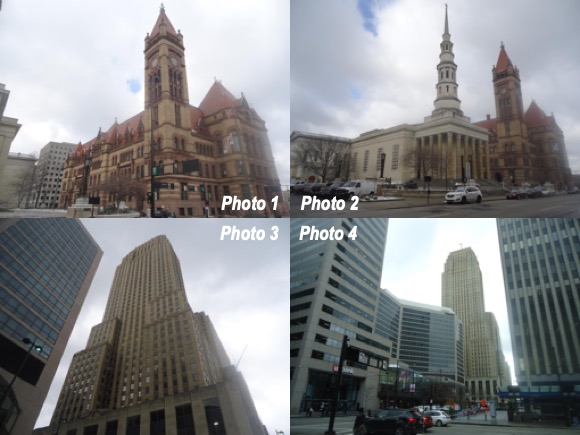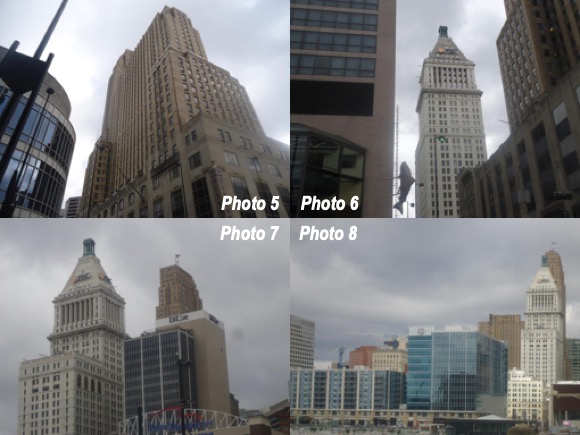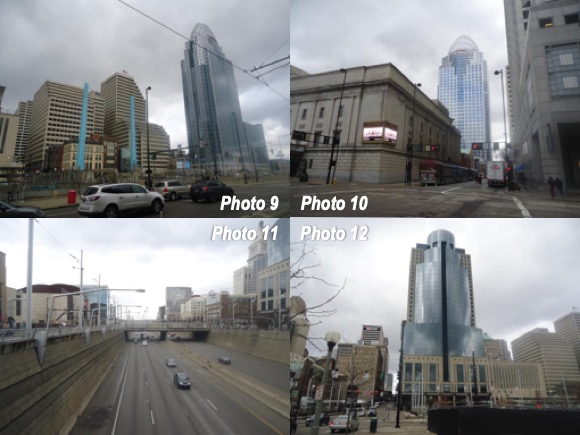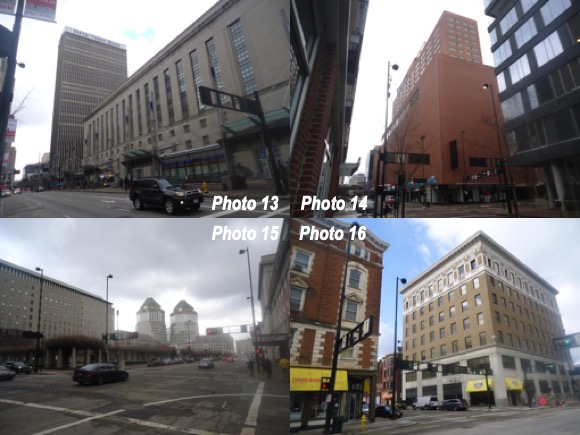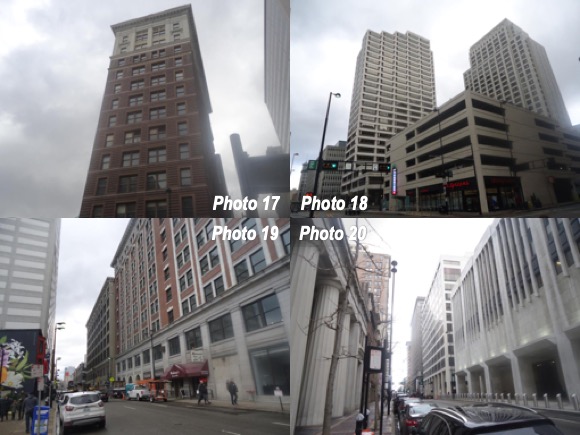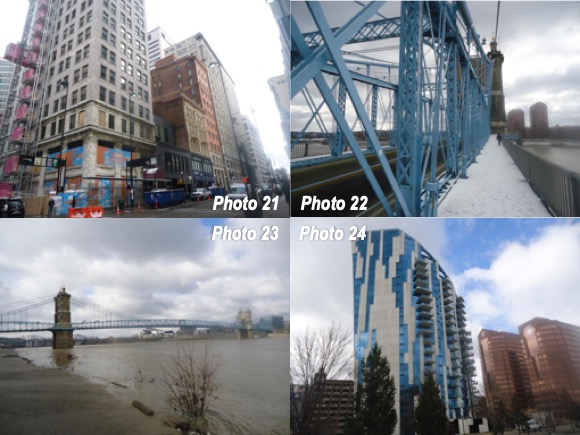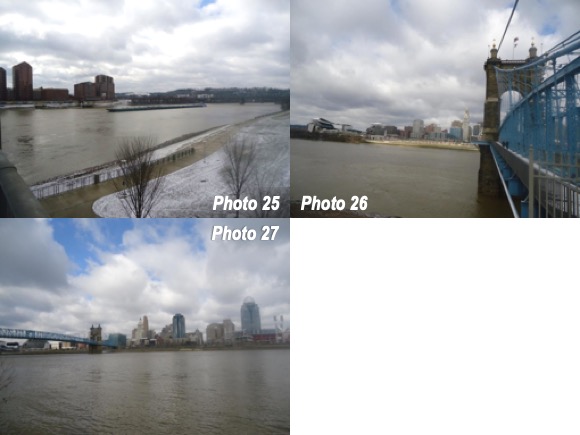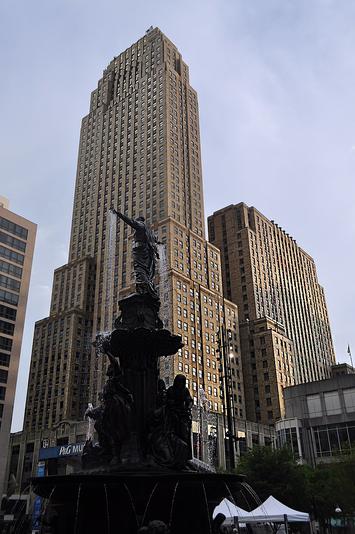
Recently I had to outrun a snowstorm, by driving to reach an appointment in Columbus (Ohio), out of fear that by morning the St. Louis airport might be closed (or the flight might be cancelled). This gave me the chance to stop by downtown Cincinnati, on the way home.
Cincinnati has one of the nation’s premier pre-World War II central business districts (CBD). There has been considerable construction since World War II, but the dense, sidewalk oriented development that characterizes pre-war CBDs is very evident in Cincinnati. The high sidewalk-oriented building downtown densities have only been built in Calgary and Charlotte since the War, and in just a few edge cities (such as Bellevue in the Seattle area and Clayton in the St. Louis area). Since then, almost all of the new business districts, whether central or edge city are far less dense.
The day started out cold and wintry. I was fearful that the weather would be too inclement to get any decent pictures. But, by the time I had driven downtown from my hotel in suburban Blue Ash, the weather had cleared substantially. This article describes my walk around downtown Cincinnati and includes photographs at the end.
For the connoisseur of early 20th century architecture, downtown Cincinnati is a delight. Like most downtown areas outside the largest, it covers little land area, less than one square mile. Our most recent estimate indicates that about six percent of the Cincinnati, OH-KY-IN metropolitan employment is downtown. This is about the same as the average among major metropolitan areas (over 1,000,000 population), but less than one-third that of leader New York (20%).
Just before the dawn of the 20th century (1893), Cincinnati’s Romanesque City Hall was opened (Photo 1).Despite nearing the end of its 13th decade, Cincinnatians can be proud of its classic design, as the city has avoided the temptation to replace it with a bland or heroic modern structure. Across the street is the St. Paul in Chains Cathedral (Photo 2).
Downtown Cincinnati has two particularly classic skyscrapers, and they are across Fourth Street from one-another.
The first is Carew Tower, completed in 1931. It is an early mixed use building, consisting of the 49 floor office tower (Photos 3 & 4), with the Hilton Nederland Plaza Hotel in the rear (Photo 5). The Carew Tower was Cincinnati’s tallest building until 2011.
The second is the PNC Bank Tower (formerly Central Trust Tower) which opened in 1913 and is neo-classical in style. When built, the 31 story building was the fifth tallest building in the world and remained the tallest in Cincinnati until the Carew Tower was finished. It was also Ohio’s tallest building until the 1930 completion of Terminal Tower in Cleveland, which held the title of tallest building in the world outside New York for decades until 1964.
The PNC Bank Tower and the Carew Tower are shown together in (Photos 7 & 8), the second taken from the John A. Roebling suspension bridge, over the Ohio River in Kentucky (see below).
The now-tallest building, the Great American Building, was completed in 2011(Photos 9 & 10). The Great American Building is 41 floors. This is fewer floors than Carew Tower, but the Great American Building is about 90 feet (30 meters) taller. Its decorative architectural treatment at the top provides the margin above the Carew Tower (above the Great American sign in Photo 10).
The fourth tallest Scripps Center was completed in 1990 and has 30 floors. It is west of the Great American Building (Photo 12).
The Great American Building and Scripps Center both front on the wide corridor in which Interstate 71 (Photo 11) crosses downtown. The full eight lane freeway is depressed and divides the more intensely developed part of the CBD from the more recently developing area to the south, with baseball and football stadia opened in the early 2000s and newer multi-family housing. Unlike the now demolished double deck freeways across downtown Boston and Seattle, which have been replaced by tunnels, the Interstate 71 depression is not obtrusive.
The fifth tallest international style Fifth Third Bank Center headquarters, at Fountain Square, was opened in 1969 (Photo 13). It is shown with the Potter Stewart Federal Courthouse in the foreground, named for the Supreme Court Justice who served from 1958 to 1981.
The Terrace Plaza Hotel (now closed) was one of the first hotels built in the nation after World War II and one of the first international style buildings. The hotel was under construction just two years after the end of the War and opened in 1949 (Photo 14).
Downtown Cincinnati is also home to the headquarters of Procter and Gamble, which has a large campus, especially for a CBD (Photo 15), where high land prices make such lower density development for a single facility especially expensive.
Probably one of the nation’s least known regional foods is Cincinnati style chili. It is a spicy chili, based on a Greek recipe and served over spaghetti. Cincinnati style chili can be hard to find much further away from Cincinnati than Indianapolis or Columbus. A visit to Cincinnati is not complete, in my view, without a visit to a Cincinnati style chili restaurant. This building near the Central Parkway at the north end of the CBD houses one such establishment, Skyline Chili (Photo 16).
Like other downtown areas of similar vintage, there are additional buildings of note and “canyons” between the closely spaced tall building(Photo3 17 to 21).
A half mile walk takes you from the north end of the John A. Roebling Bridge, across the Ohio River to Newport, Kentucky (Photos 22 to 24). This bridge, completed in 1867, is considered a model for the Brooklyn Bridge, which was completed in 1883. Newport has hotels, a convention center and frequent bus shuttle service to downtown Cincinnati.
An Ohio River barge is shown in Photo 25, heading upriver toward Huntington, West Virginia and Pittsburgh.
There are good views of downtown Cincinnati from the water level, including the western section (Photo 26) and the eastern section. (Photo 27)
As in many of the nation’s central business districts, there are many new multi-family dwellings, as inner core areas have become safer and more attractive.
Downtown Cincinnati is one of the more pleasant and healthy central business districts in the nation, and well worth walking around.
Wendell Cox is principal of Demographia, an international public policy and demographics firm. He is a Senior Fellow of the Center for Opportunity Urbanism (US), Senior Fellow for Housing Affordability and Municipal Policy for the Frontier Centre for Public Policy (Canada), and a member of the Board of Advisors of the Center for Demographics and Policy at Chapman University (California). He is co-author of the "Demographia International Housing Affordability Survey" and author of "Demographia World Urban Areas" and "War on the Dream: How Anti-Sprawl Policy Threatens the Quality of Life." He was appointed by Mayor Tom Bradley to three terms on the Los Angeles County Transportation Commission, where he served with the leading city and county leadership as the only non-elected member. Speaker of the House of Representatives appointed him to the Amtrak Reform Council. He served as a visiting professor at the Conservatoire National des Arts et Metiers, a national university in Paris.
Primary photo credit: Carew Tower by EEJCC, via Wikimedia under CC 4.0 License.
Photos 1 through 27 in story, by author.
